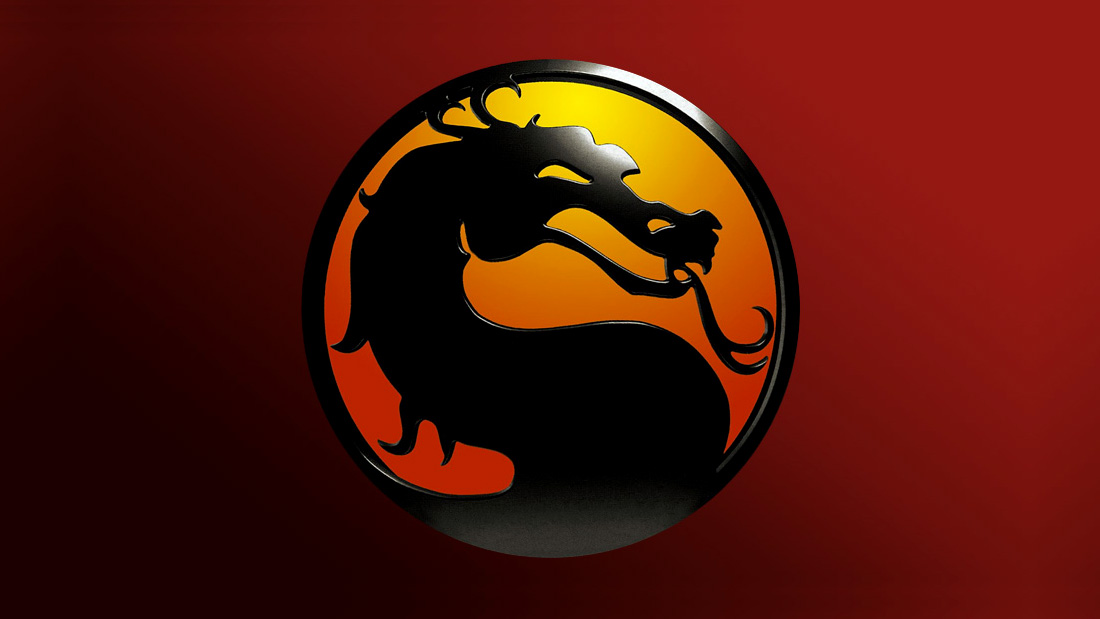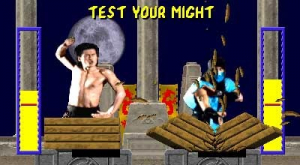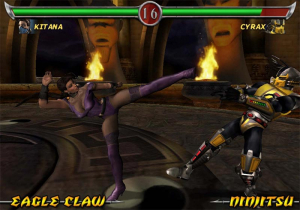I adored depictions of violence as a kid and so it shouldn’t be a shock to learn how much I also adored Mortal Kombat.
Back in a time where 18-rated movies were commonly marketed to children, it wasn’t just the Terminator and the so-ironic-it’s-actively-hilarious RoboCop action figures that occupied my time on a Sunday afternoon, but those very same movies too.
My uncle would often quip: “he’s seen more violent films than I have!” and utter such gems as “you’re a very warped child, you know that?” upon seeing my defamation of old newspapers; where I had vandalized the photographs of people inside by drawing on ‘bleeding’ wounds, severed heads and bizarre torture implements with my trusty red pen.
In history lessons, where the teacher would describe medieval executions in graphic detail, I wasn’t one of the students whimpering at the thought of such bloodshed and horror; I was the one cheering from the back front row with a smile on my face and a gleam in my eye.
I’ve always found fantasy violence entertaining and you can read into the psychology of why that is all you want, but the simple explanation that Magic: the Gathering once offered sums it up best:
“It’s fun, he doesn’t need another reason.”
As young as I was at the time though, my family always trusted me to understand that difference between what is fantasy and what is reality; a distinction I think I made very well. I hated the thought of actual pain and would never draw any pleasure in hurting anyone for real.
But in make-believe such as movies, television and especially video games; that was a different story altogether. Video games have always been predicated on some form of violence, but it wasn’t until the release of Mortal Kombat where truly gory spectacles would reach the mainstream.

Scorpion and Sub-Zero have always been series favourites because of their ‘free hit’ special moves… And the fact that they’re ninjas.
It all began in 1992 when John Tobias and Ed Boon; a couple of talented employees at the now-defunct arcade specialist Midway, came together to collaborate on a brand new project.
Inspired by their favourite Kung Fu films, the pair devised a one-on-one fighting title infused with Eastern flavours, fantastical special moves and buckets of the red stuff.
Street Fighter II; the game that practically wrote the book on 2D beat-em-ups, was easily the most popular video game doing the rounds at this time and as such Mortal Kombat had little trouble getting the green light.
In an effort not to be outdone by Capcom‘s blockbuster however, Boon and Tobias were determined to make Mortal Kombat as distinct as they could and the more they developed their early concept, the wilder the game inevitably became.
Midway was rocking a pretty sophisticated digital scanning technology at the time; an asset that allowed designers to actually scan a life-model actor and insert both their appearance and their movements into animation frames that the game would then display.
There’s no doubt that this technique has resulted in some ghastly-looking games over the years, but on the full arcade hardware, titles like Mortal Kombat looked superbly realistic for their time; something that made the on-screen violence (as silly as it was) look all the more shocking.
When a player gets hit in Mortal Kombat, you as a player can really feel it. Every punch, kick and fireball thrown comes loaded with a very tangible sense of feedback and the exaggerated spurts of ruby-red blood that accompany the action only seek to make the display even more intense.
Over the years I’ve always thought of programmer Ed Boon as a real everyday man of gaming in the sense that he just seems to have a very nice grasp of the basic design elements that make people happy.
Ed Boon loved to design special moves that would grant you a “free hit” for one; a freezing ice ball or immobilizing spear attack that would disable your opponent for a few seconds so that you could deliver a punishing follow-up (usually an uppercut) for quick and easy damage. Everyone loved it!
Then came the “fatality” finishing moves; easily the most recognizable feature of the Mortal Kombat experience and perhaps the most important ingredient that would cement not only the franchise’s incredible success, but also its profound effect on popular culture for years to come.
When playing Street Fighter II, Boon noticed the tendency for one player to become ‘dizzied’ if he sustained too much damage in a short period of time. Much like the special moves discussed above, Boon would love being the one getting his “free hits” in, but would hate it when the same was happening to him.
Boon decided to include the ‘dizzy’ feature in his own game, but moved that portion of gameplay to the final round of a match-up where the winning player would have one final strike against their opponent before being awarded the victory. Of course it didn’t take long for one bright spark to offer insight along the lines of:
“Hey, wouldn’t it be great at the end if you could just tear the other guy’s heart out?”
And from that delightful little sentiment, fatalities were born.
Inputting a secret button combination at a round’s end would now allow your character to perform a preset animation that basically resulted in the opposing player being outright butchered in some wonderfully gratuitous fashion.
From Sonya’s “kiss of death”, Scorpion’s “toasty” immolation and Liu Kang’s “stupid cartwheel” (yeah, I might have coined that one), each character’s fatality became an iconic part of their identity and it’s likely something that has kept those characters so close to fan’s (torn out) hearts over the years.
Fatalities also contributed something else to the Mortal Kombat experience; an element of mystique. You can just see how it would have went down in the arcades (where people reputedly queued for hours to play the game): a player executes a fatality to a raucous reaction and that’s when you might hear it for the first time:
“Wow, how did you do that?”
Even for the home console versions (which were released a year later), fatality input codes were not included in the game’s manual and so successfully executing one became a rite of passage and proved to everyone that you were ‘in the know’ and thus a player of some distinction.
I remember that popular magazines of the time would print out these codes for their cheat sections and I bet those publications shifted quite a few additional issues because of it.
Accompanying this air of mystery are the infrequent appearances of a hidden green ninja called Reptile; an enigmatic being that occasionally appears before a battle to offer cryptic clues (“Look to La Luna”) on how he could be fought in-game.
Over the years the number of rumours and hoaxes surrounding Mortal Kombat and its various sequels would reach fever-pitch with the developers continuing to hold people’s interest with a wealth of secret features and hidden characters.
Keeping any kind of feature in a video game secret is a nigh impossible task in today’s Internet age, which is why I feel quite fortunate to have grown up around a property that did have such an exciting air of mystery about it; in a time where you could still pull that sort of thing off.
The effect was so pronounced in fact that even Capcom got in on the action for Super Street Fighter II Turbo where they inserted their own hidden character called Akuma; a figure that has remained a hot favourite in the franchise ever since.
Pretty soon there were fewer Street Fighter II clones appearing on the market and more and more Mortal Kombat klones in their place. War Gods, Primal Rage, Eternal Champions and even Killer Instinct are all games in the same vein as Midway’s original with some “rip-offs” still appearing even 6-7 years after the orignal Mortal Kombat was released in arcades.
It clearly did a great job of distancing itself from Street Fighter II‘s formula and a lot of that probably had to do with the different cultures that those games were developed in.
Where Street Fighter II is the exemplary Japanese-style beat-em-up with an incredibly vivid albeit cartooney look, Mortal Kombat is the Western equivalent; with large and realistic-looking characters that tap into pop culture with little room for subtlety.
From the Terminator-esque Kano, the Bruce Lee lookalike Liu Kang and the thunder god Rayden; a character who looks like he just stepped right out of Big Trouble in Little China, Mortal Kombat has a very ‘made in America’ vibe about it.

Mortal Kombat II surpasses the original game in almost every respect with its better graphics, faster gameplay and overall upping of violence.
Co-creator John Tobias loved telling stories in his games too and this influence is noticeable in practically every entry in the Mortal Kombat franchise to date.
The melodramatic yarn of a tournament to save Earth from an evil overlord may seem cheesy (and just a little bit reminiscent of Enter The Dragon), but the game plays it out with such gusto that’s it’s hard not to admire it.
Character introduction and ending sequences support the narrative well and each stage backdrop is filled with the sort of thematic Eastern hallmarks that are so common in the old martial arts movies that the game draws inspiration from.
Mortal Kombat is not as strong as Street Fighter II in the gameplay department though. I can remember introducing my younger brother to Ultimate Mortal Kombat 3 a few years ago and the entire notion of quickly inputting different button commands for special moves and combos was a completely alien concept to him.
Nothing brings down a fighting game faster than one player constantly having to ask “how do you do his fireball again?”
But despite this, the games’ hilarious sampled speech (“Get over here!”), colourful characters and equally colourful depictions of blood and gore would have instantly set it apart in the minds of impressionable young kids of the time.
Mortal Kombat was a perfect fit for the aggressive teen-orientated marketing campaign supporting Sega’s Mega Drive and sure enough in 1993, the console versions of Mortal Kombat marked one of the biggest turnabouts in the whole history of video games.
An arrogant Nintendo were adamant that Mortal Kombat be censored for release on their “family friendly” SNES console meaning the blood was to be re-coloured grey (to look like sweat) and the marquee fatalities were heavily modified to be less violent- changes the company would quietly drop by the time of Mortal Kombat II.
This was because the Mega Drive version retained the full violent content (accessed via a cheat code) and the game received more favorable reviews in the gaming press as a result. It quickly outsold the SNES version three to one and this was in spite of a miserable 3 button control scheme; a rather crucial problem that the SNES rendition didn’t even possess.
Sega have always tried to downplay the importance of this eventuality by stating that the resulting court hearings on violent video games (egged-on by Nintendo no less) damaged their corporate image, but you just can’t argue with those numbers and I know that the general perception among kids in my neighborhood was that Sega had the cooler hardware because it had the “true” Mortal Kombat.
Well it wasn’t as “true” as the arcade original of course, but whatever; we were seven.

Fighting games are notorious for their difficult bosses, but who is harder and more terrifying than this cheap bastard?
But on the subject of the violent video game controversy, isn’t it amazing how little ground we’ve actually covered since 1993?
Back then, politicians and affluent middle class prats were quick to complain that the quite frankly ridiculous violence in Mortal Kombat (which looks unbelievably tame by today’s standards by the way) would poison children’s minds and what happened?
People only wanted it more and the game made a fortune.
Over twenty years later in 2015 we see a horrendously schlocky mass-murder simulator called Hatred pending release, before which more affluent middle class prats start complaining, making absurd knee-jerk reactions about its content and what happened?
People only wanted it more and the game made a fortune.
In short: LESSON NOT LEARNED.
In the years that followed the first game though, Midway would be busy building its newest multimedia franchise. The speedy release of the excellent Mortal Kombat II set new records, the player base boomed and it wouldn’t be long before Hollywood smelled box office potential and acquired the rights to a live action movie; one that made a ton of money despite mixed reviews.
And with the odd exception, there aren’t that many one-on-one beat-em-up games from this era that feel so close to the quality of Capcom’s work and just like Sonic the Hedgehog and Super Mario Bros., both Mortal Kombat and Street Fighter II have always felt so closely linked in the fabric of video game history.
It’s a link that Ed Boon seems to be aware of as he’s contacted Capcom many times over the years to try and generate interest for the game that’s been in every fan’s dreams since the Nineties: a Mortal Kombat vs. Street Fighter crossover.
Surprisingly though, it seems that Capcom isn’t interested. Despite their continued success with the Capcom vs. SNK and Marvel vs. Capcom brands, the idea of mixing it up with the Mortal Kombat property just doesn’t seem to be on their agenda.
No doubt they’re still sporting from the underwhelming performance of their 2012 release Street Fighter x Tekken; a game that surely no-one could have asked for over the aforementioned dream match-up. Oh well, they’d probably ruin it with more ill-placed ‘guest characters’ anyway…
But you can’t fault Ed Boon for his continued effort to keeping the franchise alive, if not always relevant. Following a disastrous couple of adventure game spin-offs, which in order to preserve the last vestiges of my sanity, we won’t go into, John Tobias left Midway to pursue other ventures (such as the mediocre MK klone Tao Feng: Fist of the Lotus) thus making Boon the sole frontman for the series’ future.
And to his credit, the guy has stuck it out through thick and thin. His obvious obsession for Mortal Kombat is clear as every time a new installment gets announced, he’s right there to conduct interviews and keep the franchise moving forward.
Not all of it has been good since the early days of course. The transition into 3D with Mortal Kombat 4 marked the moment where the series really began to lose its luster as the once shocking violence began to look almost comical and outdated in comparison to the new age of video gaming.
But even when the franchise reached its absolute lowest point (which according to me is Mortal Kombat: Armageddon– the game that stopped me following the series altogether), there have always been comebacks on the horizon with the more recent offerings of Mortal Kombat (2011) and the brand new Mortal Kombat X seemingly offering a deep single player/story-driven experience that other fighting games are routinely skimping on.
After a slew of mediocre ports and irrelevant sequels, not to mention the inevitable death of arcades in the West, it’s sometimes amazing to think that this franchise has survived for so long in the first place.
But as one of the most controversial video games in history, Mortal Kombat was a runaway success, it inspired a legion of copycat titles and along with Night Trap it eventually led the gaming industry to establish a (largely ineffectual) ratings system that survives to this day.
While comparisons to its competition may be unavoidable, this stylish beat-em-up really did make a name for itself and also answered that nagging question: “can blood and excessive violence truly make a good game?” with a resounding “hell yes!”



Leave A Comment